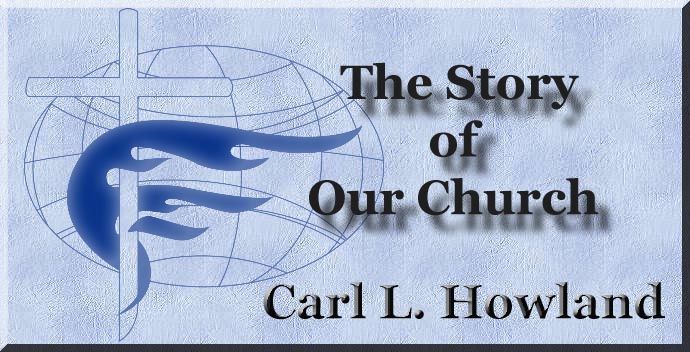
The Story of Our Church
By Carl L. Howland
Chapter 15
Part 4. ACCOMPLISHMENTS2. Sunday Schools
It has always been the disposition of the church to rejoice over an old sinner saved. We tell that he lived in vice these sixty or seventy years, that he was a rank unbeliever, but now he is ready for heaven. But at the best when the man of years is brought into the Kingdom it is only his soul that is saved. His life has been wasted. Still we should rescue all the derelicts that we can. Let us admit that children and young people need more than preventative measures—that they, too, need to be saved, for they are lost until saved. Yet the legend of the village people does emphasize the possibility and desirability of preventing the wasted life by saving not only the soul but the life. Jesus said, “Suffer the little children to come unto me.” It is the business of the church to assist them in coming. The Sunday school is a religious institution, with several responsibilities. Here are great possibilities because the mind of the child is plastic. It is open to receive truth—especially truth graphically presented. Here prejudices can be so established in the mind of the child against liquor, tobacco, dishonesty, evil associates and other sinful things that in most cases they will be carried through life. Here religious truth can be so interestingly and powerfully presented that there will be an intelligent base for right relations with God and with our fellow men. Here there can be such a spirit of personal evangelism that many will be converted. Strange as it seems, the building of a Sunday school numerically is one of the easiest things in all our church activities. And attendance is necessary—numbers are fundamental if we would do good to many—let none despise numbers. Besides the above, the Sunday school through its modern departments—the Cradle Roll and the Home Department—has access to many homes otherwise closed. The Free Methodist Church has come to an increased appreciation of the Sunday school. But we have very far to go, for there still remain about our churches tens of thousands of children and young people who attend no Sunday schools at all. And Sunday schools are often so little upon the hearts of their officers and teachers that they fall short of what they should be, either in the work of instruction or in evangelism. Nevertheless, according to the latest statistics at hand, the Free Methodist Church has the distinction of having the largest number of Sunday-school scholars in proportion to church membership of any denomination in the United States. This gratifying attendance probably holds true for Canada also. The latest statistics give 1,365 as the number of Free Methodist Sunday schools in the United States and Canada, with a total of 117,350 scholars enrolled in all departments.
|
|
 |
 |
|
|
|
-
Site Navigation
 Home
Home What's New
What's New Bible
Bible Photos
Photos Hiking
Hiking E-Books
E-Books Genealogy
Genealogy Profile
Free Plug-ins You May Need
Profile
Free Plug-ins You May Need
 Get Java
Get Java.png) Get Flash
Get Flash Get 7-Zip
Get 7-Zip Get Acrobat Reader
Get Acrobat Reader Get TheWORD
Get TheWORD
 HERE is the
story of a village situated near a dangerous cliff where were many
accidents. The dead or dying were found at the bottom. The village procured
an ambulance to care for the victims of these falls. Then someone got the
bright idea of building a fence at the top of the precipice, that none or
few would fall over. The ambulance was still employed for those who met with
accidents despite the fence.
HERE is the
story of a village situated near a dangerous cliff where were many
accidents. The dead or dying were found at the bottom. The village procured
an ambulance to care for the victims of these falls. Then someone got the
bright idea of building a fence at the top of the precipice, that none or
few would fall over. The ambulance was still employed for those who met with
accidents despite the fence.